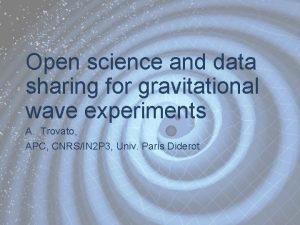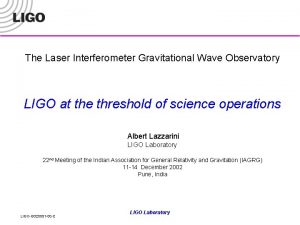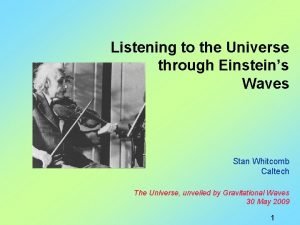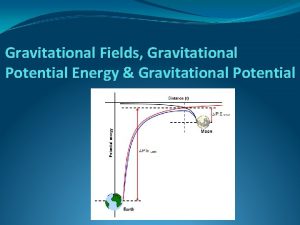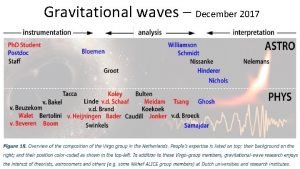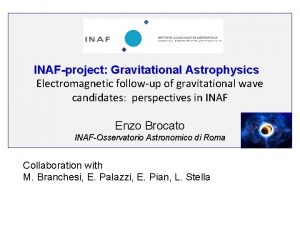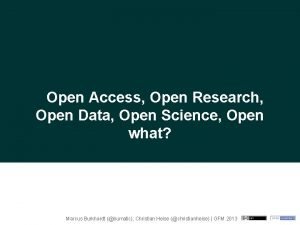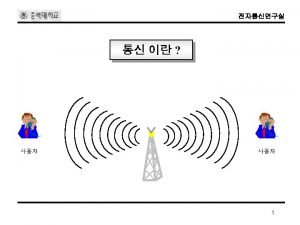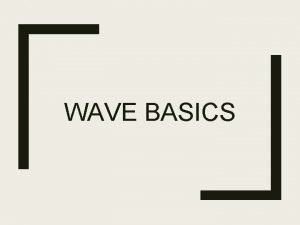Open science and data sharing for gravitational wave













- Slides: 13

Open science and data sharing for gravitational wave experiments A. Trovato, APC, CNRS/IN 2 P 3, Univ. Paris Diderot

Gravitational waves detectors • Gravitational waves: Ø ‘ripples’ in the fabric of space-time caused by accelerating masses such as colliding black holes, exploding stars, and even the birth of the universe itself. Ø transverse waves that travel at the speed of light Ø A wave stretches the space in one direction and squeezes in the perpendicular direction, then reverses the distortions planned » Typically of order 10 -21 or less! 13/12/2017 A. Trovato - ASTERICS/DADI under construction 2

What is LOSC • LOSC = LIGO Open Science Center (new name involving also Virgo under discussion) • www. gw-openscience. org or www. losc. ligo. org • LOSC provides access to LIGO and Virgo data, as well as documentation, tutorials, and online tools for finding and viewing data. • Data for long periods of data taking at the moment available only for S 5 (20052007) and S 6 (run 2009 -2010) LIGO only • The observation run O 1 (run 2015 -2016) will be released soon LIGO only • Gravitational wave data surrounding confirmed discoveries delivered: ü ü ü ü GW 150914 first detection, LIGO only, BBH, run O 1 LVT 151012 candidate BBH (significance about 2�� ), LIGO only, run O 1 GW 151226 LIGO only, BBH, run O 1 GW 170104 LIGO only, BBH, run O 2 Virgo joined the observation GW 170608 LIGO only, BBH, run O 2 GW 170814 LIGO+Virgo, BBH, run O 2 run in August GW 170817 LIGO+Virgo, BNS, run O 2 • A catalogue paper for O 2 is in preparation (several months still needed) catalogue web-page will follow BBH = Binary black Hole BNS= Binary Neutron Star 13/12/2017 A. Trovato - ASTERICS/DADI 3

Runs timeline 13/12/2017 A. Trovato - ASTERICS/DADI 4

Data download The data can be found at the web-page: • https: //www. losc. ligo. org/data/ 13/12/2017 A. Trovato - ASTERICS/DADI 5

LOSC Tutorial web page The tutorials can be found at the web-page: • https: //www. losc. ligo. org/tutorials/ Short tutorials about the basics of data analysis in the form of jupyter notebooks More specific tutorials on the data structure and how to read them 13/12/2017 A. Trovato - ASTERICS/DADI 6

Tutorial specific for GW 170817 • • The tutorial in the LOSC page is written specifically for BBH events GW 170817 is the first and only BNS discovered until now BBH and BNS have different features I adapted the tutorial to read the GW 170817 public available data and I checked the template waveform ( the template is not public at the moment) 13/12/2017 A. Trovato - ASTERICS/DADI 7

Planned detectors sensitivity evolution ar. Xiv: 1304. 0670 v 4 Multiplying the given range for the rate density for a source category, the corresponding detection rate can be calculated BNS=1. 4 M☉+1. 4 M☉ BBH=30 M☉+30 M☉ 13/12/2017 A. Trovato - ASTERICS/DADI 8

Expected BBH rates • The inferred rate of BBH mergers based on LIGO/Virgo observations is: 9 – 240 Gpc-3 yr-1 [1] • Multiplying this inferred rate for the expected range from [2], the detection rate can be calculated • O(1) events per week expected [1] Physical review X 6, 041015 (2016) [2] ar. Xiv: 1304. 0670 v 4 • A BBH catalogue is a in the plans of the collaboration already for O 2. • Contents of BBH catalogue have still to be defined. Primarily stored at losc. ligo. org 13/12/2017 Rough estimate: • Take this numbers only as indications of the order of magnitude • O 2: Ø 9 months long Ø LIGO BBH range ~800 Mpc Ø O(10) BBH events detected • O 3: Ø 12 months Ø LIGO BBH range ~1300 Mpc Ø Events: 10 x (1300/800)3 x 12/9 ~ 60 BBH events expected • O 4: Ø ~2 years long Ø LIGO BBH range ~1640 Mpc Ø Events: 10 x (1640/800)3 x 2/0. 75 ~ 230 BBH events expected A. Trovato - ASTERICS/DADI 9

BBH Catalogue in Vizier • BBH catalogue also in Vizier? ü GW events have different features than the typical events stored in Vizier! ü POSITION: Ø Can we build catalog in Vizier when sky position is poorly known? Ø Can we use a probability sky map to define the event position? E. g. store for each event some central position with some large errors to indicate the event extension on the sky map? Ø If yes, can this catalog be queried? For instance, give me all BBH whose sky map overlap with direction RA, �� ? ü WAVEFORMS: Ø Can the waveforms (and eventually the templates) be stored? ü PARAMETERS: Ø Can parameters like the SNR/False alarm rate/BH masses/BH spins be stored? Ø If yes, is it possible to search for all events with some values or (range of values) for these parameters? ü ADDITIONAL INFO: Ø is it possible to add for each event a link to the main papers that discuss it? 13/12/2017 A. Trovato - ASTERICS/DADI 10

Thank you for you attention! 13/12/2017 A. Trovato - ASTERICS/DADI 11

BBH vs BNS • Masses: Neutrons stars have usually messes of the order of the M☉ while black holes can have bigger masses (order few tens of M☉). As consequence binary black holes (BBH) are much "louder" and can be detected to much higher distances than the binary neutron starts (BNS) • Peak frequency: the maximum frequency of the GW is of O(103) Hz for BNS and O(102) for BBH this means that the BNS signal can be listen longer analysing more cycles (Virgo and LIGO are sensible between 10 Hz and 103 Hz) • E. m. counterpart: it is not expected that BBH have an e. m. counterpart (and have not been observed until now) while e. m. counterparts have been observed for the BNS starting the era of multi-messenger astronomy 13/12/2017 A. Trovato - ASTERICS/DADI 12

Expected BBH rates • The inferred rate of BBH mergers based on LIGO/Virgo observations is: 9 – 240 Gpc-3 yr-1 [1] • Multiplying this inferred rate for the expected range from [2], the detection rate can be calculated [1] Physical review X 6, 041015 (2016) [2] ar. Xiv: 1304. 0670 v 4 13/12/2017 A. Trovato - ASTERICS/DADI 13
 Gravitational wave open science center
Gravitational wave open science center 영국 beis
영국 beis Gravitational wave
Gravitational wave Gravitational wave
Gravitational wave Giant gravitational wave murmurs from universe
Giant gravitational wave murmurs from universe Wave could hear murmurs across universe
Wave could hear murmurs across universe Difference between full wave and half wave rectifier
Difference between full wave and half wave rectifier Compare and contrast transverse and longitudinal waves
Compare and contrast transverse and longitudinal waves Center tapped full wave rectifier formula
Center tapped full wave rectifier formula P and s wave chart
P and s wave chart Mechanical waves vs electromagnetic waves venn diagram
Mechanical waves vs electromagnetic waves venn diagram Example mechanical waves
Example mechanical waves Wavelength formula triangle
Wavelength formula triangle What kind of science
What kind of science
